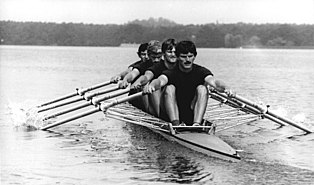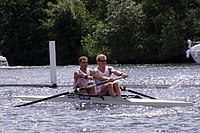Sculling

Sculling is the use of oars to propel a boat by moving the oars through the water on both sides of the craft, or moving a single oar over the stern. By extension, the oars themselves are often referred to as sculls when used in this manner, and the boat itself may be referred to as a scull.
Two-oar sculling

Two-oared sculling is a form of rowing in which a boat is propelled by one or more rowers, each of whom operates two oars, one held in the fingers and upper palm of each hand.[1] This contrasts with the other common method of rowing, sweep rowing, in which each rower may use both hands to operate a single oar on either the port or starboard side of the boat.[2] Two-oared sculling can either be competitive or recreational, but the watercraft used will vary between the two as the racing shells of competitive rowing are built for speed rather than stability. Racing shells are also far more expensive and fragile than what is suitable for the recreational rower; a typical racing shell sells for thousands[3] of dollars while an inflatable sculling watercraft can be purchased for under fifty.
Two-oar sculling in crew
Sculling, one of the two major divisions of crew (or competitive rowing), is composed of races between small, sculled boats manned by various numbers of rowers. Generally, one, two, or four athletes row these shells. These shells are classified according to the number of rowers that they can hold: singles have one seat, doubles have two, and quads have four. In keeping with this pattern, quads rowed by three people (due, for instance, to a temporary shortage of rowers) are often colloquially referred to as "triples." A rare sculling shell is the octuple, rowed by an eight-man crew, which is sometimes used by large rowing programs to teach novice rowers how to scull in a balanced, coxed boat.
The physical movement of sculling is split into two main parts: the drive and the recovery. These two parts are separated by what is called the "catch" and the "finish". The drive is the section of the rowing stroke where the face of the oars, also known as blades, are firmly placed in the water and the rower is propelling the boat forwards by pulling against the anchor the oars provide. The recovery is the section where the rower's blades are not in the water, but instead gliding above it as the rower prepares for the next stroke. The catch is the moment the blades are dropped into the water at the end of the recovery and the start of the drive, while the finish is when the blades are slipping out after the drive is done and the recovery is beginning. In order to improve balance on the recovery, the blades are feathered, or held parallel to the surface of the water, at the finish, and squared (perpendicular to the water surface) at the catch.

Competitive crew requires an efficient stroke with all rowers matching the cadence and movements of the stroke seat, the rower closest to the shell's stern. The shell may have a coxswain, or "cox," to steer the boat, encourage the crew, and monitor the rate, though coxswains are highly uncommon in competitive sculling shells and the rower in bow seat usually takes on these responsibilities instead. The bow-most rower may have equipment that attaches the skeg of the shell to one of the bow's shoes to aid with the steering; without such equipment, a sculling boat is directed by uneven pressure applied to the opposing blades.
A key (and often overlooked) technical difference between sculling and sweeping in crew is that the sculling oar handles overlap twice during the stroke, while sweep oar handles never overlap during normal rowing (because each sweeper usually holds only one oar). The overlap occurs at the midpoint of the drive and again during the recovery; because of this, scullers must hold one hand (conventionally the left hand) higher than the other at the point of overlap. To prevent this from impacting the balance of the boat, one oarlock (conventionally the port one) is rigged higher than the other prior to rowing.[1] This prevents the oar handles from colliding with one another and causing a crab or other problems.
Single-oar sculling
Template:ChineseText Single-oar sculling is the process of propelling a watercraft by moving a single, stern-mounted oar from side to side while changing the angle of the blade so as to generate forward thrust on both strokes. The technique is very old and its origin uncertain, though it is thought to have developed independently in different locations and times. It is known to have been used in ancient China,[4] and on the Great Lakes of North America by pre-Columbian Americans.
In single-oar sculling, the oar pivots on the boat's stern, and the inboard end is pushed to one side with the blade turned so that it generates forward thrust; it is then twisted so that when pulled back on the return stroke, the blade also produces forward thrust. Backward thrust can also be generated by twisting the oar in the other direction and rowing. Steering, as in moving coxless sculling shells in crew, is accomplished by directing the thrust. The oar normally pivots in a simple notch cut into—or rowlock mounted on— the stern of the boat, and the sculler must angle the blade, by twisting the inboard end of the oar, to generate the thrust that not only pushes the boat forward but also holds the oar in its pivot. Specifically, the operation of the single sculling (oar) is unique as turning the blade of the oar in figure 8 motions operates them. It is not hoisted in and out of the water like any other traditional oars. The objective is to minimize the movement of the operator’s hands, and the side-to-side movement of the boat, so the boat moves through the water slowly and steadily.

This minimal rotation keeps the water moving over the top of the blade and results in forces that transfer to the multi directional row-lock, or pivoting mount, on the side of the hull thus pushing the boat forward. Steering the boat is just a matter of rotating the oar to produce more thrust on a push or pull of the oar, depending upon which way the operator wants to go.
China
The Chinese "yuloh"[5] (from Chinese: 摇橹; pinyin: yáolǔ; Wade–Giles: yaolu) is a large, heavy sculling oar with a socket on the underside of its shaft which fits over a stern-mounted pin, creating a pivot which allows the oar to swivel and rock from side to side. The weight of the oar, often supplemented by a rope lashing, holds the oar in place on the pivot. The weight of the outboard portion of the oar is counterbalanced by a rope running from the underside of the handle to the deck of the boat. The sculler mainly moves the oar by pushing and pulling on this rope, which causes the oar to rock on its pivot, automatically angling the blade to create forward thrust. This system allows multiple rowers to operate one oar, allowing large, heavy boats to be rowed if necessary. The efficiency of this system gave rise to the Chinese saying "a scull equals three oars".
Single-oar sculling in crew
Single-oar sculling can occur in competitive rowing when a sweep boat is locked-on at the starting line of a race and the coxswain needs to adjust the direction the boat is pointed in. In order to accomplish this without pulling the boat away from the starting line, the coxswain will command a rower in the bow half of the boat to "scull" the blade of the rower in the seat behind them. By maneuvering the boat in this manner, the coxswain will be able to adjust the point of the boat without disconnecting from the starting line.[6]
Modern single-oar sculling
Modern single-oar sculling vessels come in many shapes and sizes and range from being traditional cargo barges and fishing boats to being basic or fun modes of transportation. Either way, they are typically most identifiable by their often side-mounted, unidirectional oar-locks and oars, which allow the operator, ideally, to use one hand to operate the boat. One of the greater attractions to these vessels is that they are easy and inexpensive to operate.[7] The typical modern barge-shaped and “flats”-style boats are still made from materials ranging from a variety of wood products, fibreglass, reinforced concrete, or metals.[8] Some are simply converted old motor boats. The traditional advantages of the smaller sculling craft as a hunting boat are that the operator can quietly sneak up upon fish and fowl without splashing or otherwise disturbing the still calm of the water. New commercially available single sculling hunting boats use very light materials and slick shapes for greater speeds and responsiveness.[9] Notably, the oars of the more modern single sculling vessels are now more typically mounted to pivot off one side of the boat. The operator can face either forward or aft.
Sculling in swimming
Sculling can also refer to a specific swimming drill in which the arms and hands of the swimmer are used to propel them forwards or backwards through the water. The swimmer is typically face-down in the water with their arms extended above their head or down by their hips, depending on the technique. In this position, the swimmer moves their cupped hands in a constant back-and-forth motion: wrists down with palms facing forward to move backwards, wrists slightly up with palms facing slightly back to move forward.[10]
See also
References
- ^ a b "Primer On How To Scull" (PDF). Peinert.com. pp. 4–6. Retrieved 30 July 2016.
- ^ "Eleven Rowing Insights". Usrowing.org. Retrieved 30 July 2016.
- ^ "Prices | Janousek & Stampfli Racing Boats". Janousekandstampfli.com. 20 June 2014. Retrieved 30 July 2016.
- ^ "The Shorter Science and Civilisation in China" by Joseph Needham, Colin A. Ronan, Cambridge University Press, 1978 ISBN 0-521-31560-3, ISBN 978-0-521-31560-9
- ^ "Cranks with Planks". Freepages.genealogy.rootsweb.ancestry.com. Retrieved 30 July 2016.
- ^ [1][dead link]
- ^ "How to Scull". Jesterinfo.org. Retrieved 30 July 2016.
- ^ [2][dead link]
- ^ Chad Dolbeare (22 February 1999). "Scull Boats: Waterfowl Stealth Hunting". LiveOutdoors. Retrieved 30 July 2016.
- ^ "What Are the Four Different Sculling Techniques? | Chron.com". Livehealthy.chron.com. 1 August 2013. Retrieved 30 July 2016.
External links
- "Cranks with Planks presents Sampans -n- Yulohs" (includes excerpt from G.R.G. Worcester's Junks and Sampans of the Yangtse.)
- "How To Scull A Boat" (Good article including several diagrams).
- "Rowing 101" (Lots of pertinent information about competitive rowing)

